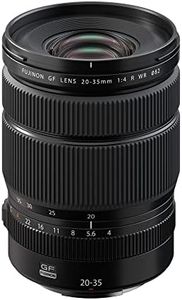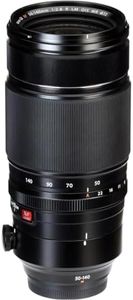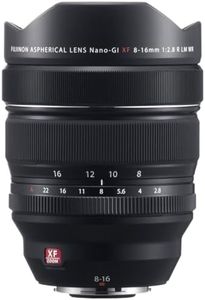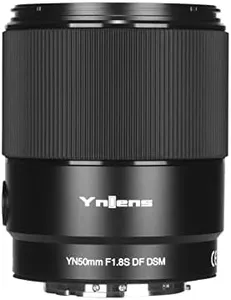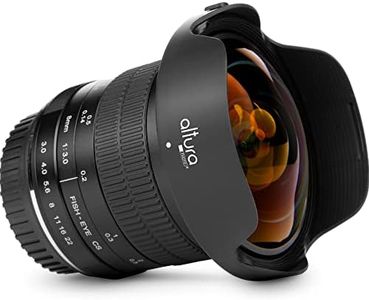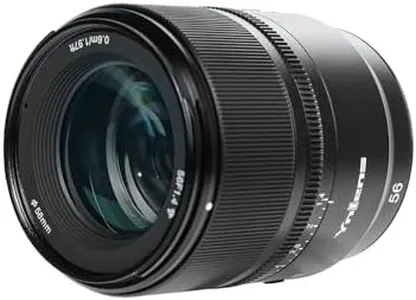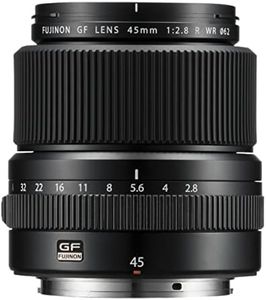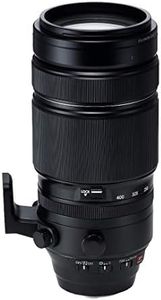10 Best Fujifilm Lenses 2025 in the United States
Our technology thoroughly searches through the online shopping world, reviewing hundreds of sites. We then process and analyze this information, updating in real-time to bring you the latest top-rated products. This way, you always get the best and most current options available.

Our Top Picks
Winner
Fujifilm Fujinon GF20-35mmF4 R WR
Most important from
14 reviews
The Fujifilm Fujinon GF20-35mmF4 R WR lens is designed for photographers who prioritize wide-angle versatility, particularly in landscape, travel, and architecture photography. With a focal length range equivalent to 16-28mm in 35mm terms, this lens offers ample flexibility for capturing expansive scenes. The constant F4 aperture ensures consistent exposure across the zoom range, which is beneficial for maintaining image quality in varying light conditions.
One of the strengths is its advanced optical construction. The lens includes 14 elements in 10 groups, featuring aspherical and ED elements, which significantly reduce distortion and chromatic aberrations. This results in high-resolution images with impressive edge-to-edge sharpness, essential for detailed landscape shots. Additionally, the Nano GI coating effectively minimizes ghosting and flare, enhancing image clarity.
The lens is relatively compact for a large format zoom, weighing 725g and measuring around 112.5mm, making it manageable for on-the-go photography. Its weather-resistant design with 12 seals allows it to function in challenging conditions, such as dust and moisture, which is crucial for outdoor photography enthusiasts. Autofocus is quick and quiet, thanks to the stepping motor, and the internal zoom mechanism ensures the lens length remains constant, aiding in ease of handling.
It lacks optical image stabilization, which might be a drawback for handheld shooting in low-light scenarios, requiring users to have steady hands or use a tripod. The Fujinon GF20-35mmF4 R WR is a robust choice for those looking to explore wide-angle photography with the GFX system, offering excellent image quality and a solid build. The absence of image stabilization is a minor downside, but the lens's other features make it a worthwhile investment for serious photographers.
Most important from
14 reviews
Fujifilm XF50-140mmF2.8 R LM OIS WR
Most important from
399 reviews
The Fujifilm XF50-140mmF2.8 R LM OIS WR is a versatile zoom lens designed for mirrorless cameras, specifically for Fujifilm X mount. It covers a focal length range equivalent to 76mm to 214mm, which makes it suitable for various types of photography, including portraits, sports, and wildlife. One of its key strengths is the constant maximum aperture of F2.8, which allows for excellent low-light performance and beautiful background blur (bokeh). Additionally, the lens features Optical Image Stabilization (OIS), which helps reduce camera shake, resulting in sharper images when shooting handheld, particularly at longer focal lengths.
The Autofocus is fast and quiet, thanks to the Linear Motor technology, making it great for capturing moving subjects. The lens is also built to withstand challenging conditions with its dust, water, and low-temperature resistance, making it reliable for outdoor use. On the downside, its weight of 2.2 pounds and size might be a bit cumbersome for some users, especially if carrying around for extended periods. Additionally, the lens has a relatively high price point, which might not be suitable for budget-conscious photographers.
For those who seek high performance and durability in a telephoto zoom lens, the Fujifilm XF50-140mmF2.8 R LM OIS WR is a strong contender.
Most important from
399 reviews
Fujifilm Fujinon XF150-600mmF5.6-8 R LM OIS WR Lens
Most important from
66 reviews
The Fujifilm Fujinon XF150-600mmF5.6-8 R LM OIS WR Lens offers a super-telephoto zoom range of 150-600mm, making it ideal for wildlife and sports photography where capturing distant subjects is crucial. The equivalent 35mm focal length extends to an impressive 914mm, and when used with teleconverters, it can reach up to 1,824mm. This extensive range provides great versatility for photographers who need to cover various distances without changing lenses.
With an aperture range of F5.6-8, the lens performs well in most lighting conditions, but it may struggle in low-light environments where a wider aperture is beneficial. The lens construction includes 24 elements in 17 groups, featuring 4 Super ED and 3 ED elements, which help to reduce chromatic aberrations and enhance image quality. Weighing in at 1605g (3.53lb), it is relatively heavy, which might be a consideration for those who prioritize portability. However, the robust build and weather resistance (WR) add to its durability, making it suitable for challenging environments.
The Optical Image Stabilization (OIS) is a significant plus, as it helps to reduce camera shake, particularly at longer focal lengths. Autofocus is also expected to be reliable and quick, thanks to the linear motor (LM). The maximum aperture of F8-16 when using teleconverters can limit the lens's performance in lower light conditions. This lens is particularly suitable for professional and enthusiast photographers who need exceptional reach and flexibility, and are willing to manage its size and weight.
Most important from
66 reviews
Buying Guide for the Best Fujifilm Lenses
Choosing the right Fujifilm lens can significantly enhance your photography experience. The right lens will depend on what you plan to shoot, your style, and your level of expertise. Understanding the key specifications of lenses will help you make an informed decision that best suits your needs.FAQ
Most Popular Categories Right Now
